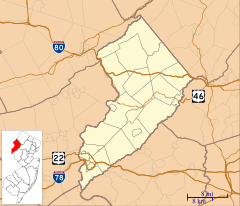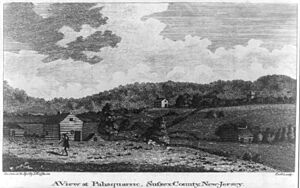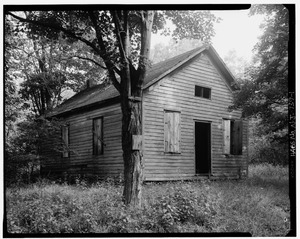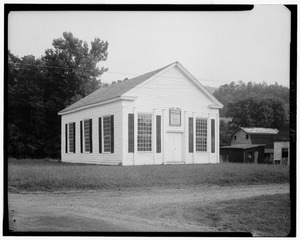Pahaquarry Township, New Jersey facts for kids
Quick facts for kids
Pahaquarry Township, New Jersey
|
|
|---|---|
| Country | |
| State | |
| County | Warren |
| Incorporated | December 27, 1824 |
| Dissolved | July 2, 1997 |
| Elevation | 168 m (551 ft) |
| Time zone | UTC-5 |
| • Summer (DST) | UTC-4 (Eastern (EDT)) |
Pahaquarry Township (pronounced pah-QUAR-ree) was a small area in Warren County, New Jersey, USA. It existed as a township from 1824 until it was officially dissolved in 1997.
Contents
History of Pahaquarry
Pahaquarry Township was created on December 27, 1824. It was formed from parts of Walpack Township in Sussex County and then became part of Warren County.
The name Pahaquarry comes from a Native American word, Pahaqualong. This word means "the place between the mountains beside the waters."
The Copper Mine
The Pahaquarry Copper Mine started operating in the 1750s. It was active for many years, from the 1700s to the early 1900s. The mine finally closed in 1928.
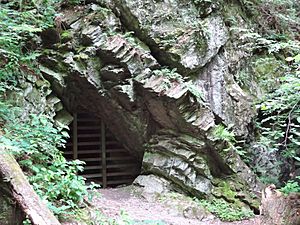
Even with new mining tools, the mine was never very successful. The copper found there was not pure enough to make a good profit.
Millbrook Village
Millbrook Village is located along the old Old Mine Road in Pahaquarry. The Van Campen family built their farms here in the late 1700s and 1800s.
In 1832, Abram Garis built a grist mill, which grinds grain, along Van Campen brook. This mill brought other businesses to the area. By the 1870s, Millbrook was a busy farm village.
However, by 1910, the mill, store, and hotel all closed. Today, this area is part of the Delaware Water Gap National Recreation Area. It is also part of the Old Mine Road Historic District.
Some buildings have been moved here from other places. Others are new, but built to look old. They help show what village life was like in the late 1800s and early 1900s. You can visit some of these buildings on summer weekends.
Local Schools
The Calno School was built in 1870 and rebuilt in 1910. It served the children of Pahaquarry until the 1940s. In 1881, there were 48 school-aged kids in the Calno area.
Only 30 students were officially enrolled, and about 15 attended daily. Teachers were not paid much and often stayed only a year or two. Most students walked to school, so schools were placed within a few miles of homes. The Millbrook School, about 5 miles north, also taught children from Pahaquarry.
The Tocks Island Dam Project
Pahaquarry is located along the Delaware River. In the late 1960s, the government bought most of the land here. They planned to build a large project called the Tocks Island Dam on the river.
This project caused most people to leave Pahaquarry. Only a few residents remained. However, local groups and many people protested against the dam. The dam was never built.
Most of the land became part of the Delaware Water Gap National Recreation Area. In 1992, Congress officially stopped the dam project.
Dissolving the Township
In March 1997, Pahaquarry had only two residents who could be part of the Township Committee. These were Mayor Jean Zipser and Harold Van Campen. They met at the Calno School and voted to dissolve the township.
An article in The New York Times in April 1997 reported on this vote. It brought national attention to Pahaquarry and its small population of six people. On July 2, 1997, Pahaquarry Township was officially dissolved. It became part of Hardwick Township.
Population Changes
| Historical population | |||
|---|---|---|---|
| Census | Pop. | %± | |
| 1830 | 258 | — | |
| 1840 | 292 | 13.2% | |
| 1850 | 460 | 57.5% | |
| 1860 | 465 | 1.1% | |
| 1870 | 405 | −12.9% | |
| 1880 | 418 | 3.2% | |
| 1890 | 291 | −30.4% | |
| 1900 | 257 | −11.7% | |
| 1910 | 205 | −20.2% | |
| 1920 | 128 | −37.6% | |
| 1930 | 80 | −37.5% | |
| 1940 | 72 | −10.0% | |
| 1950 | 67 | −6.9% | |
| 1960 | 63 | −6.0% | |
| 1970 | 71 | 12.7% | |
| 1980 | 26 | −63.4% | |
| 1990 | 20 | −23.1% | |
| Population sources: 1830-1920 1840 1850 1870 1880-1890 1890-1910 1910-1930 1930-1990 |
|||
The last official count of people in Pahaquarry was in 1990. At that time, there were 20 people living in the township. These people lived in 9 households, and 5 of them were families.
Everyone living there was White. One person was of Hispanic or Latino background. The population was spread out in age. About 15% were under 18, and 25% were 65 or older. The average age was 38 years old.
Pahaquarry in Popular Culture
- The Pittsburgh indie rock band Vehicle Flips released a song about Pahaquarry. It is called "Song for Pahaquarry, NJ (1824–1997)". This song appeared on their 2000 album For You I Pine. It reflects on the township's history.
See also
 In Spanish: Municipio de Pahaquarry para niños
In Spanish: Municipio de Pahaquarry para niños


